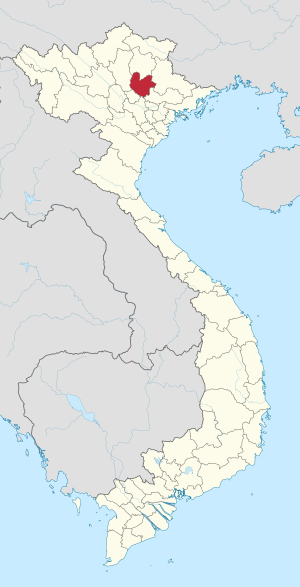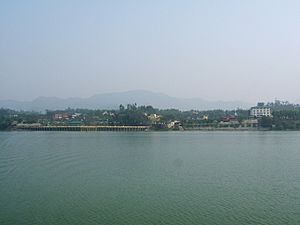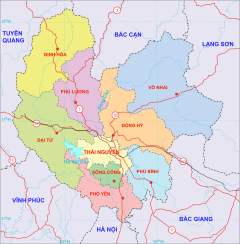Thái Nguyên province facts for kids
Quick facts for kids
Thai Nguyen Province
Tỉnh Thái Nguyên
|
|
|---|---|
|
From top, left to right: Thái Nguyên City, Museum of Vietnam Ethnic Culture, Đuổm Temple, Bắc Sơn Road, and Núi Cốc Lake.
|
|
| Nickname(s):
Great Highland
|
|

Location of Thái Nguyên within Vietnam
|
|
| Country | |
| Region | Northeast |
| Capital | Thái Nguyên |
| Subdivision | 3 cities, 6 rural districts |
| Government | |
| • Type | Province |
| • Body | Thái Nguyên Provincial People's Council |
| Area | |
| • Province | 3,536.4 km2 (1,365.4 sq mi) |
| Population
(2021)
|
|
| • Province | 1,307,871 |
| • Density | 369.831/km2 (957.858/sq mi) |
| • Urban | 434,111 |
| Ethnic groups | |
| • Vietnamese | 70.13% |
| • Tày | 11.69% |
| • Nùng | 6.35% |
| • Sán Dìu | 4.39% |
| • Sán Chay | 3.07% |
| • Others | 4.37% |
| Time zone | UTC+7 (ICT) |
| Area codes | 208 |
| ISO 3166 code | VN-69 |
Thái Nguyên is a province located in the Northeast region of Vietnam. It is a mountainous area with a total land area of about 3,526 square kilometers. In 2019, its population was around 1.28 million people.
Thái Nguyên is home to many different ethnic groups. It has rich natural resources and a pleasant climate. This makes it a good place for industries to grow. The province is also a major education hub, ranking third in Vietnam for its number of universities and colleges.
It is also known as the center of Vietnam's tea industry. A large amount of tea is produced here every year. The tea from Thái Nguyên is considered to be the best quality in Vietnam.
Contents
People and Culture
Thái Nguyên province had a population of about 1.28 million people in 2019. This means there were about 364 people living in each square kilometer.
There are around 50 different ethnic groups living in Thái Nguyên. Each group has its own language, traditions, and culture. The largest groups include the Vietnamese (about 70%), followed by the Tày, Nùng, Sán Dìu, and Sán Chay people.
The number of people living in different areas varies a lot. Mountainous regions have fewer people. Cities like Thái Nguyên City have many more people living close together.
Geography and Climate
Thái Nguyên shares its borders with six other provinces: Bắc Kạn, Vĩnh Phúc, Tuyên Quang, Lạng Sơn, Bắc Giang, and Hanoi. It acts as an important link for trade and travel with the Red River delta.
The province is about 75 kilometers from Hanoi. It is also 50 kilometers from Noi Bai international airport. Key rivers and lakes include the Công River and Núi Cốc Lake.
Thái Nguyên has many mountain ranges that run from south to north. The Tam Đảo mountain range is in the southwest. It is about 80 kilometers long and has a highest peak of 1,529 meters.
The Tam Đảo National Park protects the Tam Đảo mountain region. This park was created in 1996 and is one of Vietnam's largest national parks. It has over 20 peaks. Most of the park is covered by natural and planted forests.
There are two other mountain ranges in the province: the Ngan Son range and the Bac Son range. These mountains help protect the province from strong monsoon winds.
Weather in Thái Nguyên
Thái Nguyên has different weather zones because of its varied landscape. Some areas are colder, while others are more temperate or warm.
The average temperature in the hottest month (June) is about 28.9°C. In the coldest month (January), it's around 15.2°C. The province gets a good amount of sunshine throughout the year.
The climate has four clear seasons: Spring, Summer, Autumn, and Winter. It rains most in August and least in January. The average rainfall is between 2,000 and 2,500 millimeters per year. This climate is good for farming and growing forests.
Land and Soil
Thái Nguyên has a total land area of about 3,534 square kilometers. This land can be divided into three main types. Mountainous land makes up almost half of the area. Hilly land accounts for about 31% and is good for growing special crops and fruit trees.
Flat field land makes up about 12% of the area. Some of this land is near streams and can be affected by floods or droughts. A big challenge for Thái Nguyên is to make unused land productive again.
Economy and Growth
Farming, fishing, and industries are important parts of Thái Nguyên's economy. The province is known for its agriculture.
The capital city, Thái Nguyên, is growing very fast. It is a key entry point to northern Vietnam. The city is famous for its tree plantations. It also has historical importance because Ho Chi Minh lived here during the Resistance War. He planned important events here before moving to Hanoi.
Thái Nguyên City is also a center for heavy industries in northern Vietnam. The Thái Nguyên Iron and Steel Company (TISCO) is one of the country's top state-owned companies. It contributes a lot to Vietnam's economy.
Samsung Electronics has a very large mobile phone factory in Thái Nguyên. It opened in 2014 and employs over 60,000 people. This factory has greatly boosted the province's exports.
Thái Nguyên's exports grew a lot between 2013 and 2017. In 2020, the province had nearly 7,200 businesses. The electronics and high-tech industries are doing very well. For example, laptop production increased by over 16% in 2020.
The province's economy has developed significantly. In 2020, industry and construction made up almost 60% of the economy. The services sector accounted for about one-third. The average income per person in the province also increased.
Thái Nguyên has also improved its infrastructure and worker productivity. Many new eco-friendly and energy-efficient projects have started. The province has attracted a lot of foreign investment, especially since Samsung built its factory there.
Local authorities are working to make the province even more attractive to investors. They are focusing on high-tech industries. For example, a Hong Kong company, DBG Technology, is building a factory to make laptops, cameras, and phones. This project is expected to create over 10,000 jobs.
Another company, Trina Solar from China, is setting up a plant to produce solar power parts. This project is worth over $200 million and will create many jobs. South Korean company Samju Vina also expanded its touchscreen manufacturing in Thái Nguyên.
The province encourages private and high-tech businesses to work together. This helps create strong production networks and value chains.
Industrial Areas
Thái Nguyên has six industrial parks, covering a large area of land. Five of these parks have already received funding. The province is investing in its Quyet Thang Hi-Tech Industrial Park. This park is designed for advanced technology businesses.
The province also plans to have 35 industrial clusters. These clusters are smaller areas for specific industries. Thái Nguyên wants to attract businesses that support large companies like Samsung.
They are especially interested in electronics, electrical goods, software, high-precision mechanics, and textiles. Industrial zones in Yen Binh, Diem Thuy, and Song Cong are well-equipped for new businesses.
To raise money, the province allows investors to lease land for 50 years with a single payment. This has helped collect millions of dollars for developing industrial parks.
For example, the Diem Thuy Industrial Park has 77 projects. These projects are modern and environmentally friendly. They employ over 20,000 local people.
Water and Power
The Núi Cốc reservoir is about 25 kilometers west of Thái Nguyên city. It is a large lake that can hold 175 million cubic meters of water. The lake provides water for irrigation (watering crops) and powers a small hydroelectric power station.
This power station has three units that produce electricity. The irrigation system was built in 1977, and the power plant started working in 2010.
Transportation
Thái Nguyên Province is served by two railway lines. These lines are especially important for Thái Nguyên city. One line connects Hanoi Railway Station to Quán Triều Railway Station. The other connects Lưu Xá Railway Station to Hạ Long Railway Station.
These railway lines were built after the First Indochina War. They help connect Thái Nguyên to other important cities and ports in Vietnam.
Local Government
Thái Nguyên is divided into 9 main areas. These include 3 cities and 6 rural districts. These areas are further divided into 178 smaller communities.
| Administrative divisions of Thái Nguyên | |||||||||||||||||||||||||||||||||||||||||
|---|---|---|---|---|---|---|---|---|---|---|---|---|---|---|---|---|---|---|---|---|---|---|---|---|---|---|---|---|---|---|---|---|---|---|---|---|---|---|---|---|---|
|
|
||||||||||||||||||||||||||||||||||||||||
Fun Places to Visit
Thái Nguyên has many interesting places for tourists. Here are some of them outside the main city:
- Núi Cốc Lake
Núi Cốc Lake is the most popular attraction. You can take boat tours around the lake. The tours often share local legends and visit some of the 89 islands. Some islands have historical ruins or are protected areas for birds and goats. An eco-tourism park was built next to the lake in 2007. It has musical fountains, an animal park, and a Fairy Tale House.
- Phuong Hoang Cave
Phuong Hoang (Phoenix) Cave is one of Vietnam's largest caves. It is about 40 kilometers from Thái Nguyên city. Inside the cave, you can see amazing stalagmite and stalactite formations. Some parts of the cave get sunlight, but most areas need artificial light to explore.
- Historical Safe Zone
The Historical Safe Zone (An toàn khu – ATK) is in Định Hóa district. This was a secret place where President Ho Chi Minh lived for several years. He stayed here during the Resistance War against France (1945-1954).
- Special Local Food
Besides its famous tea, Thái Nguyên is known for its delicious local foods. These include bún chả and phở noodle dishes. You can also try Định Hóa rice, Dầy cake, and hill chicken.
The most famous food is Bánh chưng from Bờ Đậu village. This village is about 10 kilometers north of Thái Nguyên City. Bánh chưng is a sticky rice cake. It is made with glutinous rice, mung bean paste, and pork. The cake is wrapped in special aromatic leaves and tied with bamboo string. The village is busiest during the Tết holiday.
Images for kids
-
The elephant statue as a present of King Prajadhipok of Siam at entrance to a temple
See also
 In Spanish: Provincia de Thái Nguyên para niños
In Spanish: Provincia de Thái Nguyên para niños

















